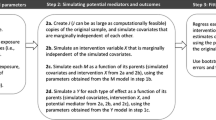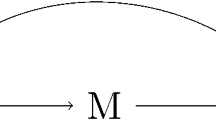Abstract
Recent advances in the literature on mediation have extended from a traditional linear structural equation modeling approach to causal mediation analysis using potential outcomes framework. Pearl proposed a mediation formula to calculate expected potential outcomes used in the natural direct and indirect effects definition under the key sequential ignorability assumptions. Current methods mainly focused on binary exposure variables, and in this article, this approach is further extended to settings in which continuous exposures may be of interest. Focusing on a dichotomous outcome, we give precise definitions of the natural direct and indirect effects on both the risk difference and odds ratio scales utilizing the empirical joint distribution of the exposure and baseline covariates from the whole sample analysis population. A mediation-formula-based approach is proposed to estimate the corresponding causal quantities. Simulation study is conducted to assess the statistical properties of the proposed method, and we illustrate our approach by applying it to the Jackson Heart Study to estimate the mediation effects of diabetes on the relation between obesity and chronic kidney disease. Sensitivity analysis is performed to assess the impact of violation of no unmeasured mediator-outcome confounder assumption.
Similar content being viewed by others
References
Albert, J. M. 2008. Mediation analysis via potential outcomes models. Statistics in Medicine 27:1282–304. doi:10.1002/(ISSN)1097-0258.
Albert, J. M., and S. Nelson. 2011. Generalized causal mediation analysis. Biometrics 67:1028–38. doi:10.1111/biom.2011.67.issue-3.
Albert, J. M., and W. Wang. 2015. Sensitivity analyses for parametric causal mediation effect estimation. Biostatistics 16:339–51. doi:10.1093/biostatistics/kxu048.
Baron, R. M., and D. A. Kenny. 1986. The moderator-mediator variable distinction in social psychological research: Conceptual, strategic, and statistical considerations. Journal of Personality and Social Psychology 51:1173–82. doi:10.1037/0022-3514.51.6.1173.
Efron, B., and R. Tibshirani. 1993. An introduction to the bootstrap. New York, NY: Chapman and Hall.
Eknoyan, G. 2007. Obesity, diabetes, and chronic kidney disease. Current Diabetes Reports 7:449–53. doi:10.1007/s11892-007-0076-5.
Goetgeluk, S., S. Vansteelandt, and E. Goetghebeur. 2008. Estimation of controlled direct effects. Journal of the Royal Statistical Society: Series B (Statistical Methodology) 70:1049–66. doi:10.1111/rssb.2008.70.issue-5.
Imai, K., L. Keele, and D. Tingley. 2010. A general approach to causal mediation analysis. Psychological Methods 15:309–34. doi:10.1037/a0020761.
Imai, K., L. Keele, and T. Yamamoto. 2010. Identification, inference and sensitivity analysis for causal mediation effects. Statistical Science 25:51–71. doi:10.1214/10-STS321.
Judd, K. 1998. Numerical methods in economics. Cambridge, MA: MIT Press.
Lee, K., M. J. Daniels, and Y. Joo. 2013. Flexible marginalized models for bivariate longitudinal ordinal data. Biostatistics 14:462–76. doi:10.1093/biostatistics/kxs058.
Lee, K., Y. Joo, J. K. Yoo, and J. Lee. 2009. Marginalized random effects models for multivariate longitudinal binary data. Statistics in Medicine 28:1284–300.
Lu, Y., K. Hajifathalian, M. Ezzati, M. Woodward, E. B. Rimm, and G. Danaei. 2014. Metabolic mediators of the effects of body-mass index, overweight, and obesity on coronary heart disease and stroke: A pooled analysis of 97 prospective cohorts with 1.8 million participants. Lancet 383:970–83.
MacKinnon, D. P., C. M. Lockwood, C. H. Brown, W. Wang, and J. M. Hoffman. 2007. The intermediate endpoint effect in logistic and probit regression. Clinical Trials 4:499–513.
Maric-Bilkan, C. 2013. Obesity and diabetic kidney disease. Medical Clinics of Northern America 97:59–74.
Pearl, J., 2001. Direct and indirect effects. Proceedings of the Seventeenth Conference on Uncertainty and Artificial Intelligence, 411–20. San Francisco, CA: Morgan Kaufmann.
Pearl, J. 2012. The causal mediation formula—A guide to the assessment of pathways and mechanisms. Prevention Science 13:426–36.
Petersen, M. L., S. E. Sinisi, and M. J. Van Der Laan. 2006. Estimation of direct causal effects. Epidemiology 17:276–84.
Robins, J. M., and S. Greenland. 1992. Identifiability and exchangeability for direct and indirect effects. Epidemiology 3:143–55.
Russell-Jones, D., and R. Khan. 2007. Insulin-associated weight gain in diabetes – causes, effects and coping strategies. Diabetes Obesity and Metabolism 9:799–812.
Sempos, C. T., D. E. Bild, and T. A. Manolio. 1999. Overview of the Jackson Heart Study: A study of cardiovascular diseases in African American men and women. American Journal of the Medical Sciences 317:142–46.
VanderWeele, T., and S. Vansteelandt. 2013. Mediation analysis with multiple mediators. Epidemiologic Methods 2:95–115.
VanderWeele, T. J. 2009. Concerning the consistency assumption in causal inference. Epidemiology 20:880–83.
VanderWeele, T. J., and S. Vansteelandt. 2010. Odds ratios for mediation analysis for a dichotomous outcome. American Journal of Epidemiology 172:1339–48.
Wang, J., M. R. Spitz, C. I. Amos, A. V. Wilkinson, X. Wu, and S. Shete. 2010. Mediating effects of smoking and chronic obstructive pulmonary disease on the relation between the CHRNA5-A3 genetic locus and lung cancer risk. Cancer 116:3458–62.
Wang, W., and J. M. Albert. 2012. Estimation of mediation effects for zero-inflated regression models 2012. Statistics in Medicine 31:3118–32.
Wang, W., S. Nelson, and J. M. Albert. 2013. Estimation of causal mediation effects for a dichotomous outcome in multiple-mediator models using the mediation formula. Statistics in Medicine 32:4211–28.
Author information
Authors and Affiliations
Corresponding author
Rights and permissions
About this article
Cite this article
Wang, W., Zhang, B. Assessing natural direct and indirect effects for a continuous exposure and a dichotomous outcome. J Stat Theory Pract 10, 574–587 (2016). https://doi.org/10.1080/15598608.2016.1203843
Received:
Accepted:
Published:
Issue Date:
DOI: https://doi.org/10.1080/15598608.2016.1203843
Keywords
- Continuous exposure
- mediation formula
- natural direct effect
- natural indirect effect
- potential outcomes framework
- sensitivity analysis




